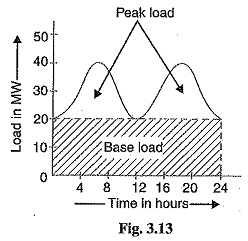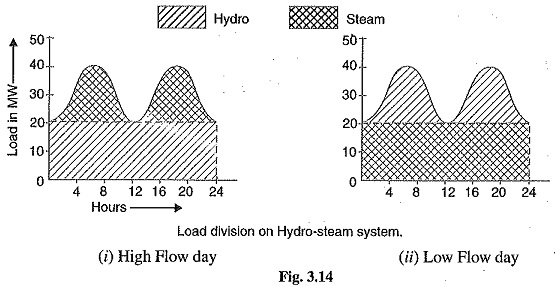Base load and Peak Load on Power Station:
The changing load on the power station makes its load curve of variable nature. Fig. 3.13. shows the typical load curve of a power station. It is clear that load on the power station varies from time to time. However, a close look at the load curve reveals that load on the power station can be considered in two parts, namely; 1.Base load 2.Peak load
1.Base load. The unvarying load which occurs almost the whole day on the station is known as base load.
Referring to the load curve of Fig. 3.13, it is clear that 20 MW of load has to be supplied by the station at all times of day and night i.e. throughout 24 hours. Therefore, 20 MW is the base load of the station. As base load on the station is almost of constant nature, therefore, it can be suitably supplied without facing the problems of variable load.
2.Peak load. The various peak demands of load over and above the base load of the station is known as peak load.
Referring to the load curve of Fig. 3.13, it is clear that there are peak demands of load excluding base load. These peak demands of the station generally form a small part of the total load and may occur throughout the day.
Method of Meeting the Load:
The total load on a power station consists of two parts viz., base load and peak load. In order to achieve overall economy, the best method to meet load is to interconnect two different power stations. The more efficient plant is used to supply the base load and is known as base load power station. The less efficient plant is used to supply the peak loads and is known as peak load power station. There is no hard and fast rule for selection of base load and peak load stations as it would depend upon the particular situation. For example, both hydro-electric and steam power stations are quite efficient and can be used as base load as well as peak load station to meet a particular load requirement.
Illustration. The interconnection of steam and hydro plants is a beautiful illustration to meet the load, When water is available in sufficient quantity as in summer and rainy season, the hydroelectric plant is used to carry the base load and the steam plant supplies the peak load as shown in Fig 3.14 (i).
However, when the water is not available in sufficient quantity as in winter, the steam plant carries the base load, whereas the hydro-electric plant canes the peak load as shown in Fig. 3.14 (ii).
Interconnected Grid System:
The connection of several generating stations in parallel is known as interconnected grid system.
The various problems facing the power engineers are considerably reduced by interconnecting different power stations in parallel. Although interconnection of station involves extra cost, yet considering the benefits derived from such an arrangement, it is gaining much favor these days. Some of the advantages of interconnected system are listed below :
- Exchange of peak loads : An important advantage of interconnected system is that the peak load of the power station can be exchanged. If the load curve of a power station shows a peak demand that is greater than the rated capacity of the plant, then the excess load can be shared by other stations interconnected with it.
- Use of older plants : The interconnected system makes it possible to use the older and less efficient plants to carry peak loads of short duration. Although such plants may be inadequate when used alone, yet they have sufficient capacity to carry short peaks of loads when interconnected with other modern plants. Therefore, interconnected system gives a direct key to the use of obsolete plants.
- Ensures economical operation : The interconnected system makes the operation of concerned power stations quite economical. It is because sharing of load among the stations is arranged in such a way that more efficient stations work continuously throughout the year at a high load factor and the less efficient plants work for peak load hours only.
- Increases diversity factor : The load curves of different interconnected stations are generally different. The result is that the maximum demand on the system is much reduced as compared to the sum of individual maximum demands on different stations. In other words, the diversity factor of the system is improved, thereby increasing the effective capacity of the system.
- Reduces plant reserve capacity : Every power station is required to have a standby unit for However, when several power stations are connected in parallel, the reserve capacity of the system is much reduced. This increases the efficiency of the system.

